Selly Manor's History
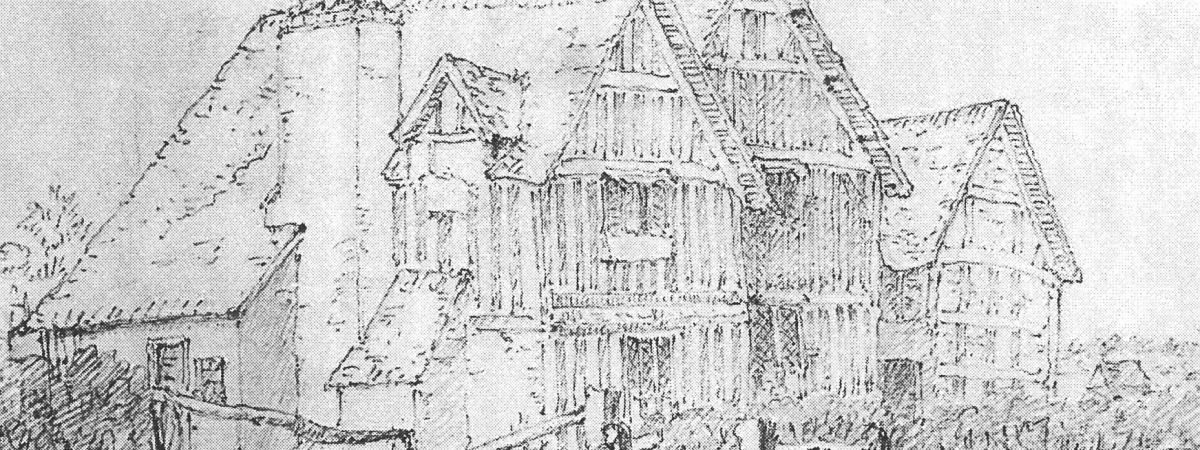
Share
The history of Selly Manor is complicated, detailed and fascinating. We love showing people around this old building on our regular tours and sharing the stories of it's life, but right at the moment that's impossible with the current situation.
So, we thought it would be good to put the story all in one place for you to explore. To keep you coming back we're going to add a little at a time to this blog - to find out when the next instalment is due see the end of the page. Now we'd like you to grab yourself a cuppa and settle down to the story of one of Birmingham's oldest buildings...
Part 1 - The Origins of Selly Manor
For many years the story of Selly Manor has been based on hearsay and unfounded theories, such as Richard III sleeping there on his way to the Battle of Bosworth in 1485. These stories grew from a lack of any comprehensive study. However, following detailed research by historian George Demidowicz in 2012, what this building was and who lived there was revealed. This research provided new insights into the life of Selly Manor and showed what makes the building important.
The name Selly Manor has been used since the building was moved to Bournville from a mile away and opened as a museum in 1916, a project funded and overseen by chocolate manufacturer and philanthropist George Cadbury. Before then the building had a variety of names including Smythes tenement, Selly Hill Farm and the Rookery. Each name reflected the status, owners and inhabitants of the building.
The building we now call Selly Manor stood in the manor of Selly, an area of land now in the suburbs of Birmingham, and today called Selly Oak and Selly Park. Despite its modern name, it was never a manor house and began life as the home of prosperous farmers. In fact, another more significant building, which might better be described as ‘Selly Manor’, is thought to have been located nearby on what was Five Gates Farm and is now the depot for Bournville Village Trust.
The earliest recorded reference to our building was in 1476. At that time it was referred to as Smythes tenement and was granted to John Othe-field and his son Thomas. The Fields were a family based in neighbouring King’s Norton. It is not known where the name Smythe came from, but documents do list Nicholas le Smith of Selleye in 1387 and a John Smyth de Selley in 1399, so this is a possible origin.
How the building of 1476 looked is uncertain, it may have been an earlier house which was knocked down in the late 1500s and then replaced. The section housing the parlour and solar rooms is the oldest part of the house and was originally adjoined by a large hall which contained the main living quarters.
The image below left shows how it might have looked in the 1500s - it has changed significantly since then. The map (below right) shows locations of significant buildings, Selly Manor is marked by its original name Smythes tenement.
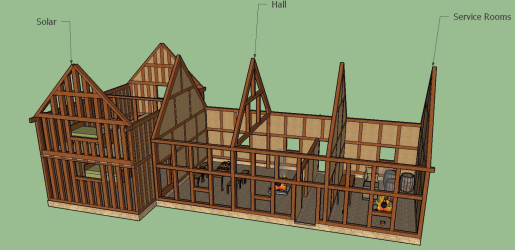
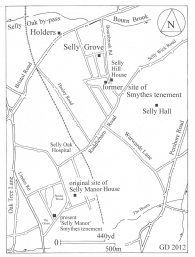
Part 2 - The Setterford and Pritchett Families
After exploring the building's medieval origins, we now move on to how the house was used in the 16th century. In 1561 William Gower leased Smythes tenement to John Setterford, his wife Phylis and her son from a previous marriage, William Pritchett. The Setterford family remained connected to Selly Manor until 1608.
John Setterford was an attorney and acted as bailiff to local landowner William Gower. This role meant he would have been a legal advisor as well as carrying out general business matters across the area, which made him a notable local figure. As the family living at Smythes tenement were more important, it is possible that this led to major changes in the building.
Until her death in 1608, Phylis Setterford continued to live in Smythes tenement. An inventory of her goods, made after her death, was compiled offering a rare insight to her life, and included contents of each room and even items within each cupboard. Phylis was an interesting character, she was accused along with her son of breaking into a property in Harborne, although no outcome is recorded.
After Phylis’ death, the house came to her grandson John Pritchett, who had been given the choice of two houses in his father’s will three years earlier. At this time he appears to have settled into his new home and started a family. John Pritchett or his eldest son, also John, at some point in the mid to late seventeenth century created the building we have now by demolishing the central hall and building the central block we see today. This included brick built fireplaces and a chimney.
The Pritchetts continued to own and live at Smythes tenement throughout the seventeenth century, the house passing from one generation to another. They were yeomen farmers who, unlike many others, owned the building and surrounding land. They were also the last owner-occupiers who lived there for any significant time, and after this the building was mostly treated as an investment rather than the home and workplace of the owners.
The first illustration below is a cross section of how we think the house may have looked at the time of Phylis Setterford. It is based on her 1608 inventory which lists the furniture, personal possessions and even food she had at the time of her death.
The second illustration is a partial photograph of that 1608 inventory which remarkably survives in the National Archives.
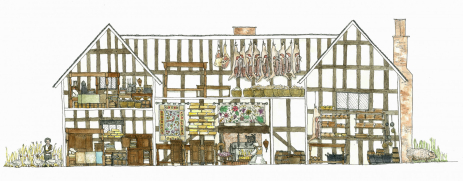
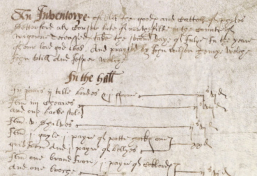
Part 3 - A Building in Decline
In the 1730s the building belonged to Thomas Hall for a short time. Thomas Hall is reported to have been imprisoned, probably due to difficulties with debt, which may have been caused by him over-extending himself financially by purchasing the Pritchett’s estate. Thomas died in prison in 1741.
The house and its associated farmland was then rented to tenants Francis Partridge and Robert Spiller for a few years in the early 1740s. It was then sold to George Larkin, and James Ingley replaced Robert Spiller as tenant. George Larkin died a bachelor in 1746, perhaps a lonely man as his will instructed that his funeral be “as late in the evening as may be without candles and that no other be invited but the six bearers”.
After several years the building, and its associated land of 65 acres, came to Francis Blount who was a merchant and dealer of goods. However he was declared bankrupt in 1761 and died two years later leaving his financial affairs in chaos.
After a number of short-term owners and tenants, the property came to Noble Reeve who was an inn-keeper in Birmingham, his inn being the Sign of the Swan at 58 High Street. Reeve probably used the farmland for growing barley for brewing at his premises. Reeve did not own the property for long as he died in 1775. Perhaps he spent his last few months residing in his house in the countryside, just a few miles outside of Birmingham.
In 1775 the building and land, then known Selly Hill Farm, was advertised for sale. The house was modestly described as ‘a genteel and convenient dwelling-house’. A benefit, the advert states, is that as well as ‘good barns, stables and other necessary out-offices’ it also came with ‘a large quantity of good manure now lying on the land, and fit for immediate use’.
In the 1780s Selly Hill Farm was owned by John Allen, an ironmonger with premises in Exeter Row in Birmingham. He rented the house and farmland to a tenant farmer. However as a successful Birmingham trader he wished to improve his social status. One way of achieving this was to establish a country residence. Selly Hill Farm was certainly not fashionable enough so he built himself a new house, across the road, named Selly Hill House. The farm itself was leased and then bought by David Owen who built yet another house lower down the hill and called it Selly Grove.
From that point onwards the old house at Selly Hill Farm was no longer the principle building in the area and there was perhaps no need to maintain and value the property as it had been before. It gradually fell into disrepair and its future became even more uncertain.
On the left below is a sketch by famous Birmingham artist David Cox, the earliest known image of the building made before 1840.
Below right is a 1775 article advertising the sale of the building. One of its principal selling points being that the house came with 'a large quantity of manure'.
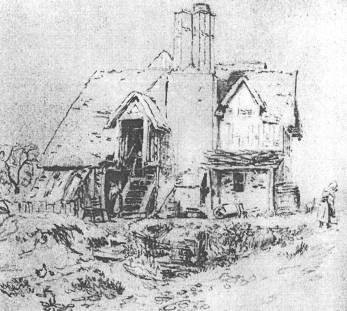
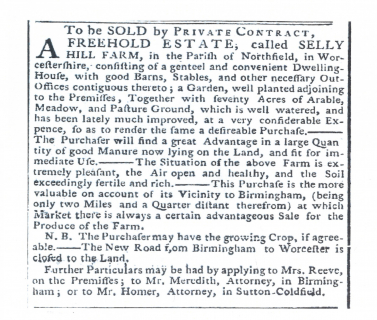
Part 4 - The Nineteenth Century
In the early nineteenth century the old house at Selly Hill was divided into two dwellings. Its tenants included David Hewett and widow Baron in 1805 but thereafter the occupants and the use of the building are unclear – it may have been used as farm labourer’s cottages. As the building was now part of the Selly Grove estate, which contained a more important house, it was rarely mentioned in official documents.
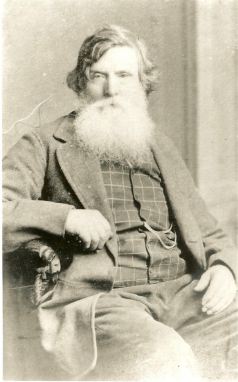
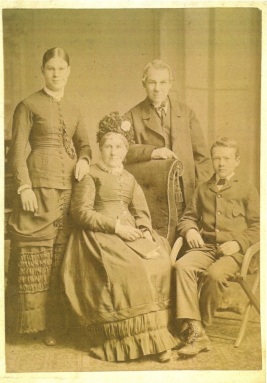
In 1895 the Rookery was up for sale as part of the Selly Grove estate. It was bought, along with several other nearby plots, by Edward Oliveri, an Italian-born wine merchant and local councillor. New houses and roads were built on some of this land, but the Rookery was temporarily ignored.
At this time, with the Rookery now in a poor state of repair, a number of photographs were taken of the building. They help to record its last years of life on Bournbrook Road as ivy began to creep over the crumbling house. A local historian, Frank Pearson and Jethro Cossins, an architect and antiquarian, visited Oliveri to encourage him to preserve the Rookery by carrying out some repairs to the building but the future of the old house looked bleak.
In 1907 Oliveri died suddenly aged 47 after catching a chill when out campaigning during the local elections. His will instructed the sale of his estate and the proceeds to be distributed. The threat to the building was imminent but a new opportunity arose. Chocolate manufacturer and philanthropist George Cadbury had been told of the building’s plight, possibly by his architect William Alexander Harvey.
George Cadbury bought the building and quickly came up with a scheme to rescue, preserve and move it. This idea s was not without controversy. The Society for the Protection of Ancient Buildings objected to the project, their secretary Thackery Turner writing to George Cadbury that “the vital interest of the building would be lost in the process of removal and rebuilding”. This did not deter George Cadbury and he pushed on with a project he saw as crucial in saving Selly Manor.
The image on the left shows Selly Manor is a state of near dereliction in about 1912. The building's saviour, George Cadbury is pictured on the right.
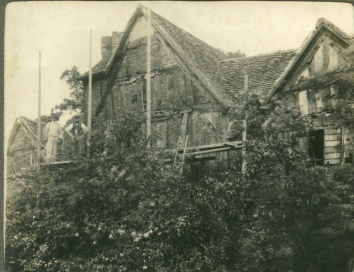
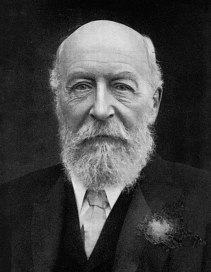
Part 6 - Dismantling Selly Manor
By 1909 architect William Alexander Harvey had started the project to have the The Rookery building dismantled. A firm of builders from Tamworth, H. Charles Mitchell, who specialised in restoration work were appointed to carry out the work. Harvey carried out detailed surveys and made plans of the building before it was moved, to ensure its accurate rebuilding.
Not all of the house could be saved. Some timbers, from years of neglect, were of no use, so Harvey sought replacement timbers from other old buildings to make repairs. Some of this material certainly came from two cottages near Droitwich. It was whilst he scoured the Warwickshire countryside for suitable timbers that he came across Minworth Greaves, the second building on this site which was bought moved, then re-erected in Bournville in 1932.
Work began on dismantling the old house in May 1912. Scaffolding was erected around the building and it was gradually taken down, beginning with the roof and then progressing downwards. Harvey kept a detailed record of the process, with numerous photographs being taken throughout. They show that letters, numbers and roman numerals were painted onto the timbers to record the location of each one. These photographs also reveal that repairs were carried out on the original site before they were moved.
Architect William Alexander Harvey is photographed below left. To the right Mitchell's carpenters can be seen during the dismantling phase of the project.
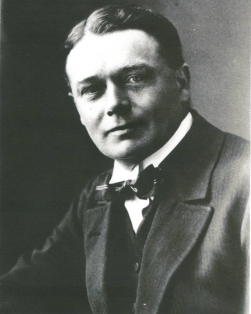
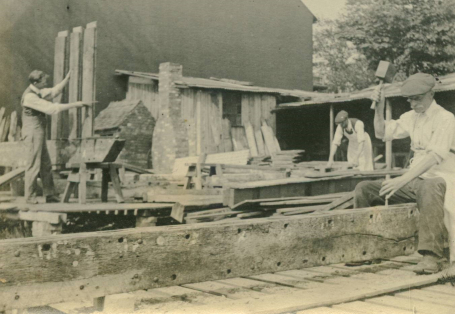
Part 7 - Rebuilding Selly Manor
Several sites were discussed for the relocation of Selly Manor. At first it seemed likely that it would be rebuilt in the centre of the village green in Bournville but after discussion a site alongside the village green was deemed more fitting.
Work began on the rebuilding in early 1913. However it turned out to be a difficult process. With the outbreak of war, the cost and scarcity of labourers, problems in repairing a building of such an age, progress was slow.
The site had to be excavated for foundations, and a cellar was added to one wing of the building. From there a stone platform was built on which to sit the timber house. The site had once been the site of a pool so a firm base was essential.
From the outset the intention was to reconstruct Selly Manor as a single dwelling as it was originally, rather than the cramped cottages it had become. Much unwanted material was discarded, including small outbuildings, brickwork from the nineteenth century and numerous layers of plasterwork. However the core of the building remained and every effort was made to ensure the principal timbers were kept and carefully restored with sensitivity to the ancient materials.
The building gradually began to take shape as brick fireplaces and chimneys were constructed, followed by the timber frame. Instead of the original wattle and daub panels between each beam, an unusual method was employed whereby tiles were inserted and then plastered. The rebuilding was completed in 1916 and opened in a museum that year.
The images below show the reconstruction of Selly Manor on the corner of Maple and Sycamore Roads in Bournville. Beginning with the stone foundations and brick fireplaces, the timber frame was then added to this stable base.
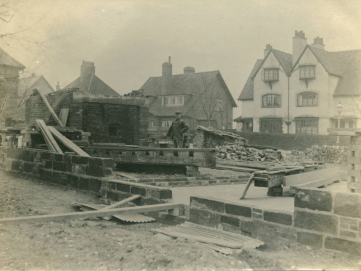
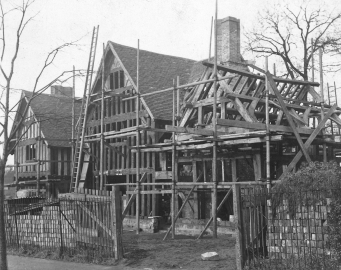
Part 8 - A New Museum for Birmingham
Selly Manor sat perfectly in the centre of Bournville. Its timber framed exterior complemented the surrounding arts and craft architecture of George Cadbury’s garden village. The introduction of a museum added to the other community buildings such as the Rest House, Meeting House, Ruskin Hall and shops around the village green.
The house, however, came to Bournville empty. Fortunately, one of George Cadbury’s sons Laurence had a keen interest in collecting. Laurence Cadbury had begun to collect antiques whilst studying at Trinity College, Cambridge in around 1908. His interests included sixteenth and seventeenth century furniture and domestic objects, and he gradually added items to Selly Manor over the next 25 years until it was near to bursting. He was advised and supported by antiques dealer Oliver Baker. The Laurence Cadbury Collection brings the manor to life and offers a rare glimpse into what life may have been like in this old house hundreds of years ago.
Today Selly Manor is a busy local community museum. Welcoming thousands of visitors each year, the museum delivers a huge variety of activities including family events, exhibitions, adult courses, children’s workshops, tours, talks and weddings. Museum staff provide a range of fun and educational tours for all ages. Especially popular are themed days for visiting school children. As George Cadbury intended, Selly Manor lies at the heart of Bournville.
Laurence Cadbury is shown below. Laurence established the museum collection at Selly Manor which today bears his name. Alongside is an early 1920s interior image of Selly Manor by photographer Harold Baker. The house has changed little to this day.
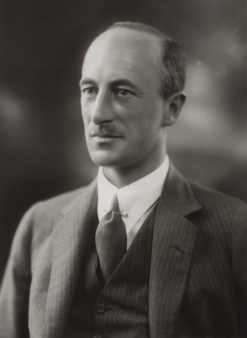
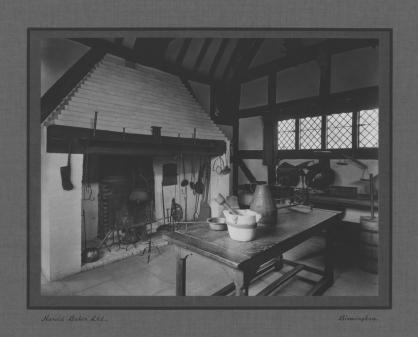
If you like this content you can find even more in the News section of our website and our Facebook page.